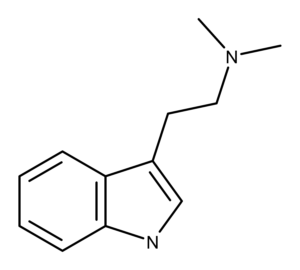DMT is a naturally occurring psychoactive molecule found in plants of several genera, including Acacia, Desmodium, Mimosa, Virola, Delosperma, and Phalaris.1 DMT has also been isolated in mammals.2,3 Recently, a study generated media coverage by finding synthesis and release of DMT in the brain of rats, leading researchers to wonder if this also occurs in human brains.4
The Chemistry of DMT
DMT was first synthesized by Manske in 1931.5 It is a powerful psychedelic tryptamine and a structural analog of other tryptamine psychedelics such as psilocybin, psilocin, and 5-MeO-DMT.
According to Shulgin and Shulgin, the hydrochloride salt form is difficult to synthesize.6 The picrate salt is used primarily for isolation and purification, the oxalate form is sometimes used in animal studies, and the fumarate salt is most often used in human studies.
The Pharmacology of DMT
In 1958, the Hungarian chemist and psychiatrist Stephen Szàra and his colleagues were the first to study the effects of DMT.7,8,9 They observed that 0.7 mg/kg resulted in effects that were similar to mescaline and LSD.7,8 These included visual hallucinations, illusions, distorted body image, mood changes, speech disturbances, and euphoria or anxiety depending on the set and setting in which the drug was used. The researchers thought the most interesting feature of DMT compared to other psychotic drugs of the day, was its remarkably rapid onset (2-5 minutes) and short duration (30-60 minutes).
DMT taken orally, smoked, or injected by itself is short-acting because of its fast oxidation by monoamine oxidase (MAO) enzymes.10 The DMT contained in the plant Psychotria viridis is the active component that is essential to the effects of ayahuasca.11 However, the effects of ayahuasca last longer than those of DMT alone because of the ß-carboline compounds contained in the other plant used to make ayahuasca, Banisteriopsis caapi. ß-carbolines (aka harmala alkaloids) such as harmaline and harmine. inhibit MAO enzymes, thus prolonging the effects of DMT.
DMT has an affinity for the serotonin receptors, including acting as an agonist of 5-HT2C and 5-HT2A, which is responsible for the psychedelic effect.12,13 A 2004 study found that DMT is an endogenous regulator of the sigma-1 receptor.14 Adding to this discovery, a 2014 study indicated that DMT (and 5-MeO-DMT) modulates the inflammatory response via the sigma-1 receptor in humans.15 These results suggest that DMT could be used for the treatment of autoimmune diseases and chronic inflammatory conditions (see DMT Pharmacodynamics in Wikipedia for a comprehensive review of DMT receptor affinity).
An interesting study done in 2010 examined how rabbits take up, metabolize, and excrete DMT and its precursor tryptamine.16 The results showed that both injected compounds went directly through the bloodstream to the brain and crossed the blood-brain barrier. Tryptamine was fully excreted by the rabbits after 10 minutes. In contrast, DMT bound to receptors in the brain and was only partially excreted. DMT was still detected in the urine 24 hours later. Even after DMT was no longer found in the urine, it was still present in the brain, with about 0.1% detected seven days later in the olfactory bulb. The researchers proposed some hypotheses to explain these results. This included tryptamine and DMT using receptors besides 5-HT2A and 5-HT2C, and DMT being taken up and stored in vesicles and being released by the appropriate stimulus.
The Applications and Potential of DMT
In a 2018 study using rats, researchers found that DMT (and other psychedelics) increase the number of synapses in the brain.17 In addition to this, the authors stated, “…serotonergic psychedelics are capable of robustly increasing neuritogenesis [growth of neurons] and/spinogenesis [growth of spines on neurons] both in vitro and in vivo.” These changes occurred in areas of the brain that regulate emotion and mood.
